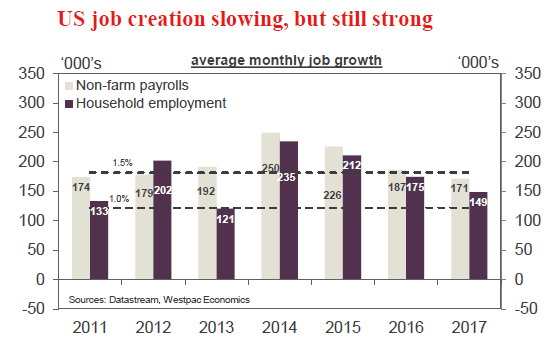Week beginning 29 January 2018
- Revised views on US Federal Reserve and AUD.
- Australia: Q4 CPI, private credit, dwelling approvals, CoreLogic house prices, and Q4 import & export price index.
- NZ: Dec residential building consents.
- US: FOMC policy meeting, employment report and employment cost index.
- Key economic & financial forecasts.
Information contained in this report was current as at 25 January 2018.
Revised Views on US Federal Reserve and AUD
Westpac has revised the outlook for the Federal Funds rate and the Australian dollar.
When we last produced our forecasts in mid December we expected that the Federal Funds rate would be increased by 25 basis points in June and December in 2018 to reach 1.875% by year’s end.
We envisaged "neutral" as zero real and expected that "zero real" would be sufficient to allow the FED to go on hold through 2019 as other major central banks, particularly the ECB and BOJ, embarked upon their own tightening programs.
Associated with that higher Federal Funds rate would be a rising bond rate and rising US dollar with targets of a rise of around 5.5% in the USD Index (DXY) and an increase in the US 10 year bond rate to 3% from 2.35% at the time.
Associated with that expected increase in the USD; an expected fall in Australia’s Commodity Price Index of around 20%; and a deteriorating yield differential as the RBA remains on hold in 2018 we expected a fall in the AUD from around USD 0.765 to USD 0.70.
This commodity view, which seems at odds with the current surge in global optimism, is partly based on our below Consensus forecast for Chinese growth in 2018 (6.2%, down from 6.9%) as the authorities slow investment growth and embrace more aggressive financial reform.
In a surprising development the USD Index has in fact depreciated by around 4% since mid-December despite a sharp widening in the US yield differential, (the US 10 year rate has increased from 2.35% to 2.62% and the three year rate has increased from 1.95% to 2.17%).
In response to this lower starting point for the USD and the expected impact on business investment from the accelerated depreciation allowances in the US tax package we have raised our forecast for growth in the US economy to 2.5% from 2.2% in 2018.
Lower tax rates; a lower USD; and a subsequent 6% lift in the US share market have markedly eased financial conditions (despite higher bond rates) clearing the way for a FED rate hike in March.
We now see the profile for the FED as 3×25 basis point hikes in March; June; and September.
That would lift the Federal Funds rate to 2.125% by September, comfortably above "zero real" and an appropriate point to pause.
We retain our target of 3% for the 10 year US bond rate while recognising upside risks given the higher profile for the FED.
The "puzzle" as to why the USD has weakened despite widening rate differentials could be explained by concerns around budget deficits associated with the Tax Package or heightened expectations for more aggressive tightening "signals" from ECB and BOJ; or the "over shoot" of around 9% in the USD Index through 2015 in anticipation of the FED’s first rate hike. (The USD INDEX has subsequently lost all its gains from 2015 and now sits near its end 2014 level before the market’s excitement about FED tightening).
Relative market confidence in the US has also lifted in the last month with the S&P 500 rising by around 6% compared to 3.3% for the Europe Index.
Our current preference is to look through these explanations, and assess the current weakness in the USD to be unsustainable.
Accordingly, associated with the upward revision to the FED profile and the much lower starting point for the USD that we saw in mid-December we are now expecting a 7% lift in the USD Index over the course of 2018, (compared to the 5.5% we envisaged in mid- December).
The rise in the AUD from USD 0.765 to USD 0.807 since mid- December can be largely attributed to the fall in the USD (most models attribute around 70% of the increase in the AUD/USD to USD weakness).
Other factors supporting that AUD outperformance are a 4.5% lift in Australia’s Commodity Price Index and a more positive assessment of Australia’s economic outlook with associated more hawkish outlook for the RBA’s policy rate.
In that regard Westpac retains its call for the RBA to remain on hold through 2018 while we retain our "end 2018" level forecast for the Commodity Price Index, indicating a circa 20% fall.
It should also be noted that markets are anticipating that the yield differential between Australian overnight rates and US rates will be around – 28 basis points by end 2018 whereas Westpac expects a differential of – 62 basis points.
Markets have come a long way from six months ago when they were predicting that the yield differential by end 2018 would be +35 basis points compared to Westpac’s forecast at the time of – 38 basis points (not far from the market’s current – 28 basis points).
At that time (mid 2017) we were comfortable to forecast eventual contraction in the AUD/USD 10 year bond spread to zero (from the prevailing 55 basis points) by end 2018. However that was when we expected the short end margin at – 38 basis points. With that expected margin now increasing to – 62 basis points we have to recognise that the spread will go negative in the second half of 2018.
In mid-December we expected an 8.5% fall in the AUD through 2018 to reflect a stronger USD; a benign RBA; and that 20% fall in Commodity Prices.
With the bigger increase (7% vs 5%) in the USD now expected and RBA and Commodity Price views unchanged we now expect a larger fall in AUD/USD (10%) than was the case in mid December.
However with the starting point much higher (USD0.807 vs USD 0.765) our revised target for AUD/USD by end 2018 is now USD 0.72. That "new" level for the AUD by year’s end would be consistent with an NZD/USD level of USD0.65.
The week that was
The past week has been a quiet one for Australian data, the only release of significance being the Westpac-MI leading index. That said, there has been plenty to fill the headlines, with the Q4 New Zealand CPI; Bank of Japan; and President Trump’s trade agenda all in focus.
First, for the Westpac-MI Leading Index, the December outcome was strong at +1.41%, pointing to above-trend growth in early 2018. Almost all of the inputs were positive in the month, except hours worked. Of particular note were the contributions provided by commodity prices (benefiting from global growth and US dollar weakness); dwelling approvals (which have surged) and consumer sentiment (currently in an upswing following a soft 2017). Despite this strong growth signal, we remain of the view that negatives around housing; household incomes and consumers’ willingness to spend will restrict the growth upswing and see aggregate momentum hold below trend in 2018.
Turning then to inflation, this week saw the release of New Zealand’s Q4 CPI. Our New Zealand team and the market had anticipated that strength in fuel prices and other transport costs would see a quarterly gain of 0.4%, leaving annual inflation at 1.9%yr – just below the mid-point of the RBNZ’s inflation target range. While strength in transport costs was seen, it was largely offset by widespread weakness in tradeable goods prices, the result of strength in the New Zealand dollar. Our New Zealand team also note that there was potentially a one-off factor in the mix as well, a 6% drop in new car prices that may have been due to an extension of coverage as part of the three-year re-weighting that took effect this quarter (as well as New Zealand dollar strength). Non-tradeable prices were largely as expected at 0.5%, buoyed by rents and new dwelling prices.
Coming a week before the release of the Australian CPI, the New Zealand CPI outcome has additional significance. Weakness in tradeables inflation has been a recurring feature of the Australian inflation story through 2017, and the above New Zealand outcome signals this may again be the case in Q4. Our forecast for the Australian headline CPI stands at 0.8%, 2.1%yr. The degree of risk to this figure from tradeables inflation is likely in the order of 0.2ppts – the average disappointment versus the market forecast in recent quarters. Unlike New Zealand, rents and house purchase costs are losing momentum in Australia, resulting in a soft pulse for core or underlying inflation. We see the average of the RBA core measures at 0.5% in Q4, leaving the annual gain little changed at 2.0%yr. All of the detail behind our forecasts is contained in our CPI preview by Justin Smirk, but the take home point is simple. On both a headline and core basis, inflation will remain at the bottom of the RBA’s target range for the foreseeable future. Further, based off the 2017 experience, the risks to this profile are to the downside.
Moving then to the northern hemisphere, of those watched closely by global markets, the Bank of Japan was the first central bank to meet in 2018. Their latest outlook released after the January meeting took a cautious approach to communication. At the margin, the forecasts for growth and inflation point to a further erosion of downside risks; however, the unchanged median forecasts imply no significant change in their solid (but hardly strong) expectations. Activity growth is expected to slow from 1.9%yr in fiscal 2017 to 1.4%yr in 2018 and then to 0.7%yr in 2019. Inflation is also set to remain below target, at 0.8%yr in fiscal 2017; 1.4%yr in 2018 and 1.8%yr in 2019 (excluding the 2019 consumption tax hike). Those anticipating a material shift in policy in the near term are therefore likely to be disappointed. That said, there is cause to expect the 10yr JGB yield target to be nudged higher from zero to 0.1% later in 2018; and, if market conditions allow along the way, a further scaling back of asset purchases. This trend in the Bank of Japan asset purchases, combined with an end to those by the ECB at end-2018 and the US FOMC’s accelerating balance sheet normalisation, represent a material change in the global monetary policy stance and market liquidity supply through 2018 and into 2019. Careful assessment of G3 central bank intentions will therefore be crucial this year. Note that the ECB meet tonight and the FOMC next week.
On the FOMC, as outlined by Chief Economist Bill Evans, Westpac Economics has revised our US policy expectations for 2018, adding a third hike and bringing forward their timing. We now look for a 25bp hike at each of the March; June and September meetings, taking the fed funds rate to 2.125% (mid-point of range). The primary reason for these revisions is the loosening of financial condition in the US over the past month, principally via a weaker US dollar.
Since the beginning of November 2017, the DXY US dollar index has fallen from almost 95 to near 89 currently ( – 6%) amid strengthening expectations for global growth and Euro Area/ Japanese monetary policy. While expectations for robust global growth are justified, those for a material change in the stance of monetary policy in Europe and Japan are not. Consequently, we still expect a circa 7% rally in the US dollar (DXY) in 2018, but that will still leave its level below our prior profile. For the US dollar, there are considerable risks in both directions. The market response to protectionist comments this week from the Trump administration highlight that, amid a robust global economy, US protectionism is likely to be to the detriment of their currency. Further government shutdowns will also affect confidence negatively. That said, a weaker US dollar and December’s tax reform package loom as upside risks for inflation, growth and therefore the stance of monetary policy.
As we have highlighted regularly, the terminal fed funds rate for this cycle will depend on how the stance of monetary policy influences overall financial conditions. Three hikes would see the fed funds rate above neutral and would also be followed by balance sheet normalisation at maximum effect in Q4 2018 and Q1 2019. Financial conditions should therefore tighten materially and weigh on growth. However, if term yields remain suppressed and/or the US dollar fails to rally as we expect, then the current rate hike cycle could have further to run. At this time, this is not our base case.
New Zealand: week ahead & data wrap
This week’s December quarter CPI was the last major piece of data before the RBNZ’s February interest rate review. We have been expecting the RBNZ to leave the OCR on hold for a long while, while financial market pricing has been creeping towards interest rate hikes this year. With the exchange rate rising and inflation surprising to the downside this week, our view is looking closer to the mark. We expect that inflation will linger below 2% for some time yet. And with the economy showing signs of slowing, it is hard to see the RBNZ hiking any time soon.
Soft December quarter inflation…
Consumer prices rose by just 0.1% in the December quarter. That was below analysts’ and our own forecasts for a 0.4% increase. It was also lower than the Reserve Bank’s November forecast for a 0.3% rise. This soft result saw the annual inflation rate dropping back from 1.9% down to 1.6%.
Underlying this softness was widespread weakness in the prices of tradable goods, which are mostly imported. Prices in this group fell by 0.3% over the quarter, with virtually every item with some imported content coming in below our forecasts (the exception was fuel prices, which rose 6%).
There are two possible culprits here. The first is the New Zealand dollar, which strengthened through the middle part of 2017. Exchange rate movements typically affect retail prices with a lag of two to four quarters. It’s likely that earlier gains in the New Zealand dollar are still flowing through into retail prices of imported products. That said, the rise in the exchange rate last year wasn’t a particularly large or sustained one.
However, the results also suggest a lack of price pressures for internationally-traded goods more generally. Softness in global inflation has puzzled forecasters for many years since the global financial crisis. With the world economy now on a stronger footing, many have been expecting higher inflation to follow – and a few central banks such as the US Federal Reserve have already started to lift interest rates in anticipation.
Yet there is little evidence of that inflation emerging yet. It’s true that inflation rates have risen from the near-zero levels that prevailed a couple of years ago, as oil prices have been rising sharply instead of falling. But there is little sign of price pressures spreading to the manufactured goods that New Zealand imports. That’s consistent with ongoing reports of strong competitive pressures through the retail sector.
In contrast, the more persistent non-tradables component (which relates mainly to domestically produced goods and services) rose by 0.5%. Rents and new dwelling prices continued their steady rise, and were joined by seasonal increases in domestic airfares, car rentals and accommodation. However, even in these groups, it is notable that annual inflation has failed to break higher over the past year. Annual non-tradables inflation is currently sitting at 2.5% – broadly where it has been for the past 18 months, and still below its long run average.
…continuing into 2018…
We expect some of the softness in December’s inflation result will reverse in the early part of this year. Nevertheless, it’s looking very likely that inflation will remain below the RBNZ’s 2% target midpoint through 2018. While there are signs that the period of very weak global inflation that we saw in recent years is dissipating, we’re certainly not in an environment where imported inflation is about to rocket higher. In addition, the continuation of strong competitive pressures in the retail sector means that the domestic prices of imported consumer goods are likely to remain soft for an extended period.
We’ve also seen the NZD grinding higher since the start of this year, and this week we revised up our forecasts for the NZD/ USD over 2018. This reinforces our expectation for softness in tradables prices over the coming months.
Similarly, the chances of a significant rise in domestic inflation look slim. Recently released GDP figures showed that the New Zealand economy had been growing at a solid pace in recent years, with growth topping out at 4% through 2016. And that wasn’t just because of population growth either – per capita growth has also been fairly healthy in recent years. But even with solid domestic activity and rising pressures in the construction sector, we did not see a material lift in non-tradables inflation.
Now, growth has eased off, and recent business sector indicators point to a further softening in activity through the early part of 2018. Combine those conditions with changes in government charges (like reduced costs for tertiary education and doctors’ visits), and a strong rise in domestic inflation over the coming year looks like a longshot.
…will keep the RBNZ on the sidelines for some time yet
We are now well past the period of very weak inflation that we saw in the wake of the financial crisis. Nevertheless, inflation remains stubbornly below average. Furthermore, it’s looking very doubtful inflation will rise back to 2% in mid-2018 like the RBNZ was expecting at the time of their November Monetary Policy Statement. Coming on top of signs that the momentum in GDP growth is fading, this makes it hard to argue for an OCR hike anytime soon.
Market pricing for an OCR hike edged back a little following the softer than expected CPI result and is consistent with a rate increase in the first quarter of 2019. We still think that is too soon, and maintain our forecast for the OCR to remain on hold until the final quarter of 2019.
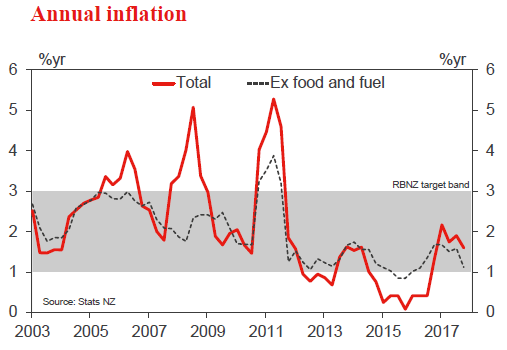
Data Previews
Aus Dec CPI
Jan 31, Last: 0.6%, WBC f/c: 0.8%
Mkt f/c: 0.7%, Range: 0.4% to 1.4%
- The September quarter CPI came in broadly as we expected printing 0.6%qtr compared to Westpac’s forecast of 0.7%. The market median was 0.8%. The annual rate moderated to 1.8%yr compared to 1.9%yr in Q2 and 2.1% in Q1. The average of the core measures, which are seasonally adjusted and exclude extreme moves, rose just 0.4%qtr and, in annual terms, was flat on Q2 at 1.9%yr.
- With a solid bump up from tobacco, auto fuel & domestic holidays but not much else, Westpac’s forecast for the headline CPI is 0.8%qtr lifting the annual pace from 1.8%yr to 2.1%yr. Core inflation is forecast to print 0.5%qtr (0.54% at two decimal places) lifting the annual rate to 2.0%yr. The trimmed mean is forecast to rise 0.52%, while the weighted median forecast is 0.57%.
- See our Q4 CPI Preview for more details on why we see downside risks to this forecast.
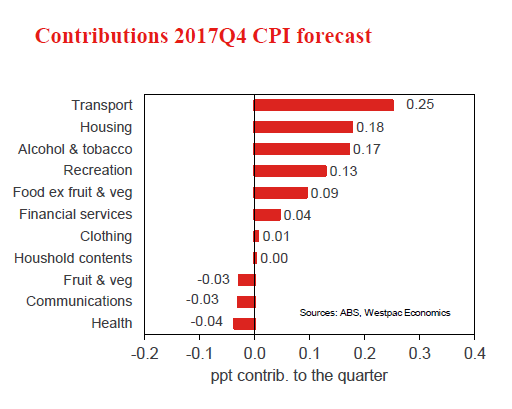
Aus Dec private credit
Jan 31, Last: 0.5%, WBC f/c: 0.4%
Mkt f/c: 0.5%, Range: 0.4% to 0.6%
- Credit to the private sector grew by 0.5% in November, a touch above the 0.4% monthly average for 2017.
- For December, we anticipate a rise of 0.4%.
- Housing credit is slowing gradually, a trend that is likely to continue at this late stage of the cycle as the sector responds to tighter lending conditions. The 3 month annualised pace is 5.7% currently, down from 6.8% in March. In November, housing credit grew by 0.44%, 6.4%yr.
- Business credit is volatile month to month around a moderate upward trend as businesses expand investment. The November outcome was an above par increase of 0.7%. For December, we anticipate a result more in line with the 2017 monthly average of 0.3%.
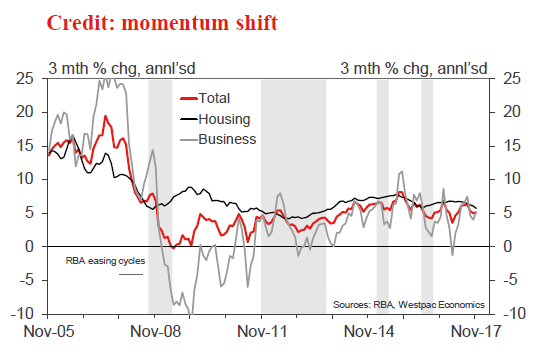
Aus Dec dwelling approvals
Feb 1, Last: 11.7%, WBC f/c: – 8.0%
Mkt f/c: -7.6%, Range: -12.5% to -3.0%
- Dwelling approvals posted a surprise surge in Nov, up 11.7% vs expectations of a decline. The result was driven by an extraordinary spike in Vic high rise approvals that more detailed data shows centred on the CBD, Docklands and Southbank. While not down to one single ‘mega project’, the spike almost certainly relates to a handful of very large projects in the inner city. Approvals across the rest of Australia were much weaker, down 2.0% in the month following Oct’s 8.3% drop.
- There looks to be some residual strength in the Vic market, with site purchases – a reasonable lead indicator for high rise activity – up in 2016-17 but still well below their 2015 peak. That said, Nov high rise approvals were an extreme high well above the state’s previous peaks. As such, with conditions softening across other markets and segments, there is a risk of a sharp correction lower in Dec. We expect an 8% pull back, but a double digit monthly fall is plausible.
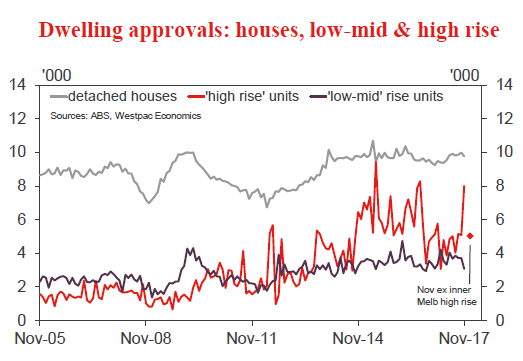
Aus Jan CoreLogic home value index
Feb 1, Last: – 0.5%, WBC f/c: – 0.3%
- Australia’s housing market posted a weak finish to 2017, with prices nationally dipping 0.1% in Nov and a further 0.5% in Dec to be down 0.6% over the final quarter, the first negative quarterly result since early 2016. Annual growth slowed to 4.3%yr, an abrupt slowdown on the 11.5% peak in May.
- The daily index points to a further softening in January, with prices down about 0.3% nationally. As always, housing data should be treated with extra caution around the summer holiday low season as light trading means information can be less reliable.
- More generally, early 2018 is shaping as a key test for the market, with ‘transitional’ impacts from last year’s macro prudential tightening set to ease. With weakening foreign buyer demand, downbeat buyer sentiment and surging apartment supply also in the mix, the market’s post holiday opening performance will be an important tone setter for 2018.
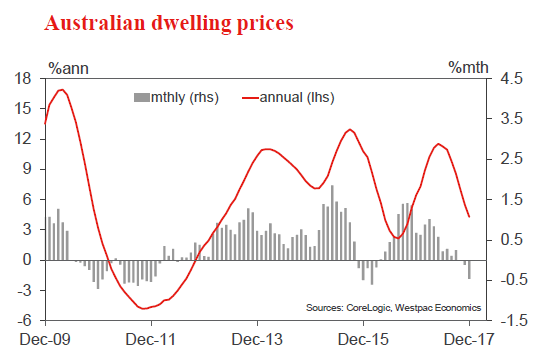
Aus Q4 import price index
Feb 1, Last: -1.6%, WBC f/c: 3.5%
Mkt f/c: 1.5%, Range: -1.5% to 5.0%
- Prices for imported goods were little changed over the past year, edging 0.4% lower, notwithstanding a drop of 1.6% in the September quarter.
- Roll forward to the December quarter, import prices likely took a step higher, increasing by a forecast 3.5%.
- The cost of imports rose as the Australian dollar dipped in the final quarter of 2017, a move which has since been reversed. In Q4, the Aussie fell almost 3% to average US76.8¢ and declined by the same magnitude on a TWI basis.
- In addition, the bill for fuel imports rose as global energy prices increased in the period.
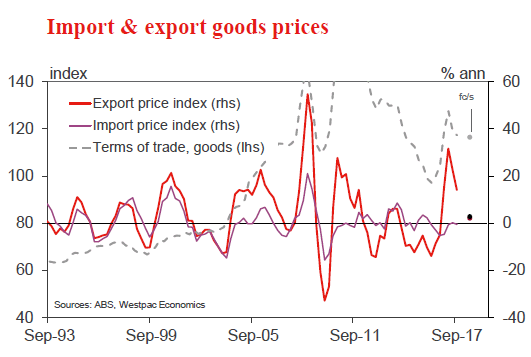
Aus Q4 export price index
Feb 1, Last: – 3.0%, WBC f/c: 2.7%
Mkt f/c: 2.0%, Range: -3.5% to 3.0%
- The sharp rebound in export prices during 2016 and into early 2017 was punctuated by meaningful falls in the June and September quarters (-5.7% and -3.0%), as commodity prices eased back from recent highs.
- In the December quarter, global commodity prices took on a more resilient tone. In the period, the RBA commodity price index increased by 2.9% in AUD terms and was broadly flat in US dollar terms.
- For Q4, we expect export prices to increase by 2.7% and be 2% higher than at the end of 2016.
- The terms of trade for goods, on these estimates, declined by 0.8% in the quarter, to be 2.5% below the level of a year ago.
- As to prices for services, an update will be available with the release of the Balance of Payments on March 6.
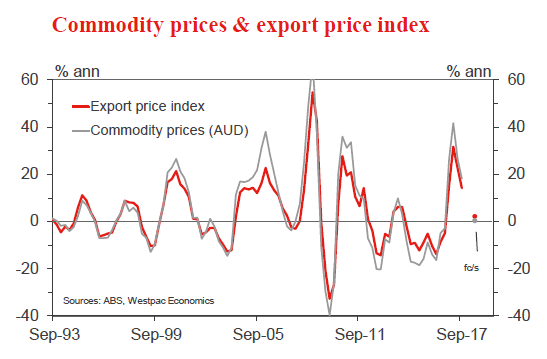
NZ Dec residential building consents
Feb 2, Last: 10.8%, WBC f/c: 2.0%
- Residential consent issuance rebounded in November, rising 10.8% over the month. In part, this strong result reflected some payback following earlier softness.
- Smoothing through recent month-to-month volatility, consent issuance remains at firm levels. We expect a further modest gain of 2% in December. Much of the recent strength in issuance has been centred on Auckland where there continues to be a significant shortfall of housing.
- We expect that the level of residential building activity will remain elevated for some time. However, we continue to expect that building activity will increase at a gradual pace over the next few years. As we’ve highlighted for some time, rising costs, as well as difficulties sourcing skilled labour and credit are acting as a brake on activity.
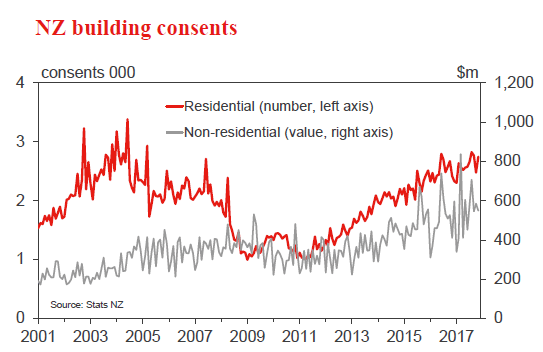
US FOMC Jan policy meeting
Jan 30 – 31, fed funds rate last 1.375%, WBC 1.375%
- Following the BoJ and ECB’s meetings last week, this week sees the first meeting of the FOMC for 2018. It will also be Chair Yellen’s last
- The January meeting is a simple affair, the decision statement the only method of communication. Since December, a weaker US dollar; little change in term interest rates; and the passing of tax reform all warrant greater short and medium-term optimism over the outlook.
- Due to the above factors, we have revised our expectations for the FOMC.
- We look for 25bp hikes at the March; June and September meetings. At that point, the fed funds rate will be above neutral and the balance sheet unwind in full effect. This will be an appropriate time to pause and assess.
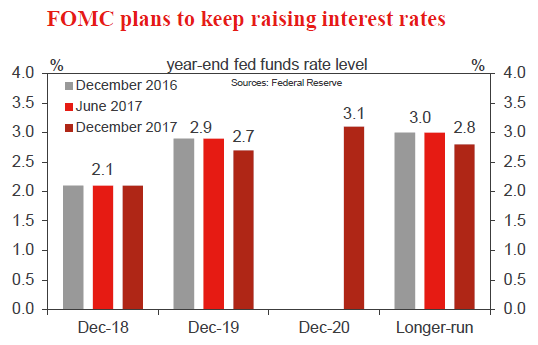
US Jan employment report
Feb 2, nonfarm payrolls, last 146k, WBC 170k
Feb 2, unemployment rate, last 4.1%, WBC 4.1%
- Month to month volatility in nonfarm payrolls remains significant. In the December quarter, gains of 211k and 252k in October and November were followed by a 148k rise in December. The average for the quarter was 204k, a step up from the average of the past six months and 2017 overall.
- We believe this acceleration at end-2017 is noise rather than signal, particularly given the economy is at full employment and the pace of employment growth in 2017 was well ahead of population growth.
- As a consequence, we look for a (still strong) 170k outcome in January. Looking ahead, 2018 is likely to see a further deceleration in employment growth to circa 155k per month, down from around 190k in 2016 and 170k in 2017.
